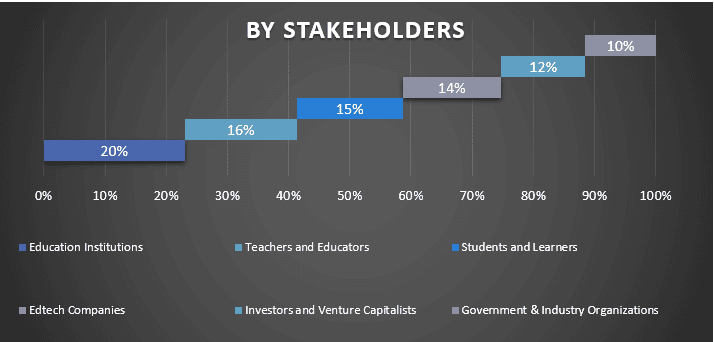- Home
- About Us
- Industry
- Services
- Reading
- Contact Us
Middle East EdTech Market: Current Analysis and Forecast (2023-2030)
Emphasis on Sector (Pre-K, K-12, Higher Education, Corporate, Lifelong Learning); Application (Hardware, Software, Services); End-User (D2C, B2B, B2B2C, P2P) and Country

The Middle East EdTech market was valued at USD 4157.79 Million in 2022 and is expected to grow at a strong CAGR of around 13.89% during the forecast period (2023-2030) owing to the growing smartphone and internet penetration that access to the technology of online learning. Moreover, the rising government initiatives across Middle Eastern nations are investing significantly in digital infrastructure and educational technology to enhance the quality of education. Although only USD30 million was invested in EdTech companies in the Middle East and North Africa region in 2020, the amount of investment is set to increase steadily from a low base, according to Dubai-based venture capital company Global Ventures in 2021. Adding to this, the embrace of online learning platforms, adaptive learning technologies, and virtual classrooms has become increasingly prevalent addressing the diverse needs of students and fostering a culture of continuous learning that drives the growth of the market.
Some of the major players operating in Abwaab, Noon Academy, almentor.net, Baims, Synkers FZ-LLC, Alef Education, AlGooru Holding Inc., Zedny Educational Services SAE, Aanaab platform, Innovera. Several M&As along with partnerships have been undertaken by these players to facilitate customers with hi-tech and innovative sectors/technologies.
Insights Presented in the Report
“Amongst sectors, the higher education is expected to grow with a significant CAGR during the forecast period (2023-2030).”
Based on sector, the market is segmented into pre-k, k-12, higher education, corporate, and lifelong learning. Higher education is expected to grow with a significant CAGR during the forecast period (2023-2030). The surge in demand for flexible learning options coupled with advancements in e-learning technologies has led to the proliferation of Massive Open Online Courses (MOOCs) and interactive online resources. Moreover, EdTech in higher education in the Middle East is unlocking opportunities for remote learning, research collaboration, and skill development tailored to the demands of the evolving job market.
“Amongst end-users, D2C held a dominant share of the market in 2022.”
Based on the end user, the EdTech market has been classified into D2C, B2B, B2B2C, and P2P. D2C held a significant share of the market in 2022. With the surge in urbanization and infrastructure development, digital screens and displays have become integral components of real estate marketing. Moreover, high-profile property launches, upscale developments, and smart city projects leverage DOOH to showcase architectural renderings, amenities, and lifestyle offerings.
“Saudi Arabia leads the market.”
The EdTech market in Saudi Arabia held the dominant share of the market driven by a combination of government initiatives, increased investment, and a growing awareness of the importance of technology in education. In addition, the country has made substantial investments in education technology recognizing its potential to enhance learning outcomes and address educational challenges. For instance, As per the Arab News, in January 2024, Saudi Arabia’s educational technology sector continues to garner investor interest as iStoria secured SR5 million (USD 1.3 million) in a seed funding round. Moreover, the government’s commitment to modernizing education and fostering a knowledge-based society has driven significant investments in digital learning solutions.
Middle East EdTech Market Report Coverage
Report Attribute | Details |
Base year | 2022 |
Forecast period | 2023-2030 |
Growth momentum | Accelerate at a CAGR of 13.89% |
Market size 2022 | USD 4157.79 million |
Country analysis | UAE, Saudi Arabia, Qatar, Kuwait, Rest of Middle East |
Major contributing Country | UAE is expected to grow at the highest CAGR during the forecasted period |
Companies profiled | JCDecaux, ELAN, EyeMedia, Hills Advertising L.L.C., Elevision Media LLC, HYPERMEDIA, BackLite Media, Viola Communications, ENG WORLDWIDE, and Dooha Media |
Report Scope | Market Trends, Drivers, and Restraints; Revenue Estimation and Forecast; Segmentation Analysis; Impact of COVID-19; Demand and Supply Side Analysis; Competitive Landscape; Company Profiling |
Segments Covered | By Sector; By Application, By End-User; By Region/Country |
Reasons to buy this report:
- The study includes market sizing and forecasting analysis validated by authenticated key industry experts.
- The report presents a quick review of overall industry performance at one glance.
- The report covers an in-depth analysis of prominent industry peers with a primary focus on key business financials, sector portfolios, expansion strategies, and recent developments.
- Detailed examination of drivers, restraints, key trends, and opportunities prevailing in the industry.
- The study comprehensively covers the market across different segments.
- Deep dive regional level analysis of the industry.
Customization Options:
The Middle East EdTech market can further be customized as per the requirement or any other market segment. Besides this, UMI understands that you may have your own business needs, hence feel free to connect with us to get a report that completely suits your requirements.
Table of Content
Research Methodology for the Middle East EdTech Market Analysis (2023-2030)
Analyzing the historical market, estimating the current market, and forecasting the future market of the Middle East EdTech market were the three major steps undertaken to create and analyze the adoption of the Middle East EdTech in major countries. Exhaustive secondary research was conducted to collect the historical market numbers and estimate the current market size. Secondly, to validate these insights, numerous findings and assumptions were taken into consideration. Moreover, exhaustive primary interviews were also conducted, with industry experts across the value chain of the Middle East EdTech market. Post assumption and validation of market numbers through primary interviews, we employed a top-down/bottom-up approach to forecasting the complete market size. Thereafter, market breakdown and data triangulation methods were adopted to estimate and analyze the market size of segments and sub-segments of the industry pertains to. Detailed methodology is explained below:
Analysis of Historical Market Size
Step 1: In-Depth Study of Secondary Sources:
Detail secondary study was conducted to obtain the historical market size of the Middle East EdTech market through company internal sources such as annual reports & financial statements, performance presentations, press releases, etc., and external sources including journals, news & articles, government publications, competitor publications, sector reports, third-party database, and other credible publications.
Step 2: Market Segmentation:
After obtaining the historical market size of the Middle East EdTech market, we conducted a detailed secondary analysis to gather historical market insights and share for different segments & and sub-segments for major regions. Major segments are included in the report as sector, application, and end-user. Further country-level analyses were conducted to evaluate the overall adoption of testing models in that region.
Step 3: Factor Analysis:
After acquiring the historical market size of different segments and sub-segments, we conducted a detailed factor analysis to estimate the current market size of the Middle East EdTech market. Further, we conducted factor analysis using dependent and independent variables such as sector, application, and end-user of the Middle East EdTech market. A thorough analysis was conducted of demand and supply-side scenarios considering top partnerships, mergers and acquisitions, business expansion, and sector launches in the Middle East EdTech market sector across the globe.
Current Market Size Estimate & Forecast
Current Market Sizing: Based on actionable insights from the above 3 steps, we arrived at the current market size, key players in the Middle East EdTech market, and market shares of the segments. All the required percentage shares split, and market breakdowns were determined using the above-mentioned secondary approach and were verified through primary interviews.
Estimation & Forecasting: For market estimation and forecast, weights were assigned to different factors including drivers & trends, restraints, and opportunities available for the stakeholders. After analyzing these factors, relevant forecasting techniques i.e., the top-down/bottom-up approach were applied to arrive at the market forecast for 2030 for different segments and sub-segments across the major markets. The research methodology adopted to estimate the market size encompasses:
- The industry’s market size, in terms of revenue (USD) and the adoption rate of the Middle East EdTech market across the major markets domestically
- All percentage shares, splits, and breakdowns of market segments and sub-segments
- Key players in the Middle East EdTech market in terms of sectors offered. Also, the growth strategies adopted by these players to compete in the fast-growing market
Market Size and Share Validation
Primary Research: In-depth interviews were conducted with the Key Opinion Leaders (KOLs) including Top Level Executives (CXO/VPs, Sales Head, Marketing Head, Operational Head, Regional Head, Country Head, etc.) across major regions. Primary research findings were then summarized, and statistical analysis was performed to prove the stated hypothesis. Inputs from primary research were consolidated with secondary findings, hence turning information into actionable insights.
Key Stakeholders of EdTech Market in the Middle East Region

Market Engineering
The data triangulation technique was employed to complete the overall market estimation and to arrive at precise statistical numbers for each segment and sub-segment of the Middle East EdTech market. The data was split into several segments & and sub-segments post studying various parameters and trends in the areas of the sector, application, and end-user of the Middle East EdTech market.
The main objective of the Middle East EdTech Market Study
The current & future market trends of the Middle East EdTech market were pinpointed in the study. Investors can gain strategic insights to base their discretion for investments on the qualitative and quantitative analysis performed in the study. Current and future market trends determined the overall attractiveness of the market at a regional and country level, providing a platform for the industrial participant to exploit the untapped market to benefit from a first-mover advantage. Other quantitative goals of the studies include:
- Analyze the current and forecast market size of the Middle East EdTech market in terms of value (USD). Also, analyze the current and forecast market size of different segments and sub-segments
- Segments in the study include areas of the sector, application, and end-user
- Define and analysis of the regulatory framework for the Middle East EdTech industry
- Analyze the value chain involved with the presence of various intermediaries, along with analyzing customer and competitor behaviors of the industry
- Analyze the current and forecast market size of the Middle East EdTech market for the major region
- Major countries of regions studied in the report include Saudi Arabia, UAE, Egypt, Kuwait, and the Rest of Middle East
- Company profiles of the Middle East EdTech market and the growth strategies adopted by the market players to sustain in the fast-growing market
- Deep dive regional level analysis of the industry
Frequently Asked Questions FAQs
Q1: What is the current market size and growth potential of the Middle East EdTech market?
Q2: What are the driving factors for the growth of the Middle East EdTech Market?
Q3: Which segment has the largest share of the Middle East EdTech market by application?
Q5: Which country will dominate the Middle East EdTech market?
Q6: Who are the key players operating in the Middle East EdTech market?
Related Reports
Customers who bought this item also bought










